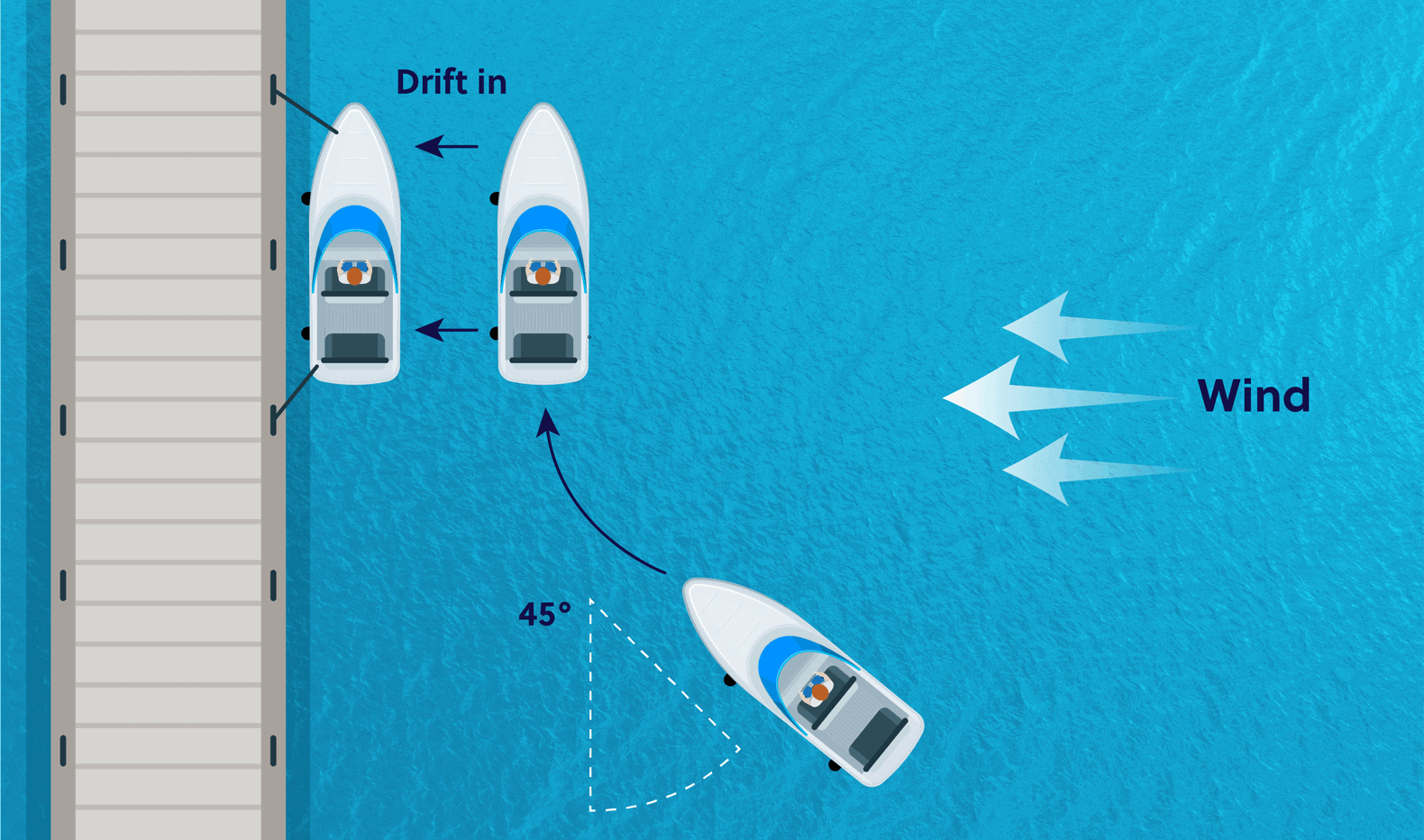How to Dock a Boat

For boating beginners, learning how to dock a boat properly and confidently is often more difficult than boating itself.
The combination of tight docking spaces, expensive boats all around, and inevitable onlookers make docking a source of stress for many boaters.
In this article, we will outline the docking process and the best way to dock your boat depending on the current/wind direction.
Follow these simple steps to reduce your stress and learn how to dock your boat like a seasoned pro.
Docking Preparation
Prepare Dock Lines and Fenders
Before you approach the dock, take a minute to prepare your dock lines and fenders for docking. This can be done at a standstill before you start the docking process.
Bring your boat to a stop of very slow speed (if you have a helper) and prepare the following:
- Dock Lines: Attach your dock lines to the cleats at the bow and stern of the boat. Make sure the bowline and stern line are loose and ready to grab.
- Fenders: The fenders need to be out and adjusted to the height of the dock you are approaching. Having the fenders out will reduce the possibility of damaging the hull of your boat.
Embracing Neutral
Do not be neutral on neutral. Controlling and reducing your speed on approach is the key to docking a boat.
You will constantly be putting the boat in and out of neutral to reduce the speed and momentum, and ultimately to get the boat to do what you want it to do.
Coming in too quickly is the most common culprit of docking mishaps. If your approach is too fast, it will take too long to correct, which leads to overcorrection.
This is a technique that can be practiced on the open water so that you can get a good feel for controlling the micro-movements of your vessel at slow speeds.
Docking Process by Wind Direction
Docking with No Wind

- Approach the dock at 45 degrees
- Stop the boat parallel to the dock (1-2 feet away)
- Safely reach for the dock when you are close enough
- Tie the bowlines and stern lines to the dock cleats
Docking is a fairly straightforward and repeatable process when you are boating on a calm day. If you are a new boater, practicing docking when there is little to no wind or current is a great way to get your feet wet (or dry in this case).
Approach the dock at a 45-degree angle in order to come to a stop parallel to the dock. Because boats do not have breaks, you will likely be using reverse to stop the momentum of the boat. Make sure to factor in the stopping distance as the craft.
Current/Wind Onshore

- Approach the dock at 45 degrees
- Stop the boat parallel to the dock (about 3-4 feet away)
- Safely reach for the dock when you are close enough
- Tie the bowlines and stern lines to the dock cleats
When the current/wind is coming directly at the dock, mother nature is trying to push you at the dock. This is one of the easiest situations because the weather is working in your favor.
Because the wind is assisting, you will want to approach the dock at a 45-degree angle. This angle allows the boat to drift into place.
At a slow speed, use your steering wheel to steer your boat close to the dock and put it into reverse gear to bring it to parallel to the dock (about 2 to 3 feet out depending on the windage).
At this point, let the wind slowly push the side of the boat into the dock.
Current/Wind Astern

- Approach the dock at 10 degrees
- Put the boat in reverse to stop the momentum
- Pass stern line ashore and tie to dock cleats
- Let the wind pull the bow close to the dock
- Tie the bowline to the dock cleats
When the wind is coming from behind, you will want to approach the dock at approximately 10 degrees. This will position the bow of the boat pointed at the dock.
Make sure that your fenders and dock lines are ready and as you get close to the dock, put the boat in reverse to stop the momentum, and pass the stern line ashore.
Once the stern line is attached to the dock cleat, the wind holds the bow close to the dock and the bowline can be secured.
Current/Wind Ahead

Twin-engine Boat Procedure
- Approach the dock on the port side (left of an observer aboard) at 15 degrees
- Put both of the twin-screw engines in slow reverse to slow the way of the boat
- Pass bow line ashore
- Put the port-side (left) engine in reverse
- Let the wind and slow momentum of the engine pull the stern close to the dock
- Tie the bow line to the dock cleats
Right-hand Single-engine Boat Procedure
- Approach the dock on the port-side (left of an observer aboard) at 15 degrees
- Put the right-hand single-screw engine in slow reverse to slow the way of the boat
- Put the port-side (left) engine in reverse
- Let the wind and full power of the engine pull the stern close to the dock
- Pass and tie both the bow line and stern line to the dock cleats
Left-hand Single-engine Boat Procedure
- Approach the dock on the port side (left of an observer aboard) at a very shallow angle. Almost parallel to the dock
- Pass bow line ashore and secure to the dock cleats as an after-spring line
- Turn the rudder away from the wall
- Place engine in slow forward position to force stern in
- Pass stern line and secure to the dock cleats
When the wind is coming from ahead, you will want to approach the dock at approximately 15 degrees (or almost parallel to the dock if you have a left-hand single engine boat). This will position the bow of the boat pointed at the dock and utilize the wind and slow power of the engine to position the boat safely.
Make sure that your bow and stern lines are ready and as you get close to the dock, put the boat in reverse (or forward and away from the wall for left-hand single engines only) to stop the momentum, and pass the bow line ashore. Once the bow line is attached to the dock cleat as a spring line, the wind holds the bow close to the dock and the stern line can be secured.
Current/Wind Offshore

- Approach the dock at 60 degrees
- Pass the bowline ashore and tie to dock cleat
- Use the engine to slowly bring the stern in (either by putting the inboard engine into reverse or using the engine and rudder)
- Tie the stern lines to the dock cleats
If the wind or current is offshore, it is trying to push you away from the dock. This is inherently more difficult because mother nature is actively fighting what you are trying to do.
Approach the dock at a steeper angle of approximately 60 degrees. You will need a little more power on this style of docking to get you close enough to the dock to tie down your lines.
If you have an inboard engine, you may be able to bring the stern in by engaging reverse gear or you will need to use the engine and rudder to bring the stern in.
How to Tie a Boat to the Dock
Once you get your boat to the dock like a pro, you will want to make sure it stays there.
For docking with cleats, the best knot to use is the cleat hitch knot. The cleat hitch is very simple to master and very secure.
Bottom Line
Like with anything, docking a boat takes practice. However, once you understand the feel of your vessel for the 5 maneuvers above, repeating this process becomes much more intuitive over time.
The main thing to remember is to keep your speed very slow. This will allow you to make micro-corrections if needed.
And last, but not least, don’t be afraid to safely back up and try again if your approach was off. Always make sure to carefully check for other boats before doing this.

About Deb Sauvé
This article may contain affiliate links which I earn a commision through when you purchase. As an Amazon Associate I earn from qualifying purchases.
Please read why I do this and my commitment to accurate and compelling content.

